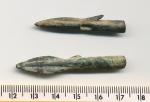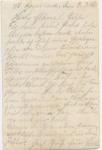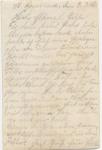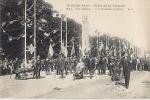-
Posts
388 -
Joined
-
Last visited
Content Type
Profiles
Forums
Blogs
Gallery
Events
Store
Everything posted by Eduardo
-
Hello Paul and Nicolas, Excuse me for sticking my nose here but I also have some Roman poins that would like to know more about. These two poins come from La Mancha in Spain and I don't know if they are Roman or Iberic. Will apreciale any information. Eduardo
-
And this one is a view of the trenches near Rems. The card was printed in Paris by E. Le Deley. To all a Happy New Year in which we can keep enjoying this great forum. Eduardo
-
These two new cards were Santa's Christmas present for my collection. The first one shows a very dramatic view of the last fugitives leaving Ypres. The card was printed in Paris by: Imp. Phot. Neurdein et Cie.
-
A friend in Austria with the help of his mother, has translated the card as follows: The front of the card shows four persons at a house in front of a window. Through the open window you can see a hole in the ceiling. The persons are marked from 1 - 4 The names are written on the left of the photo: 1 Gefreiter Gartenschl?ger ( Gefreiter is a military rank. In USA it is "private") (Gartenschl?ger is a typical German family name) 2 Gefreiter Beyer 3 ...(unreadable)... Beizer or Jeizer 4 ...(unreadable) The text at the back: "St. Boni...an...(unreadable location) dem 3.3.15. (date)" "Liebe Eltern l. Geschw!" (Liebe Eltern = dear parents) (l. Geschw! = abbrev. of "dear brothers and sistters) "F?r dein Packerl, liebe Magda, besten Dank." (Thank you very much for your parcel, dear Magda) (Magda = womans name, probably his sister) "Anbei sende ich Euch eine Photographie von unseren Quartier in Brillreville" (Herewithin I send you a picture of our camp in Brillreville) (Brillereville is hard to decipher - might be slightly different, but it sounds French, so it might be in France or Belgium) "Das Haus ist zusammen geschossen" (The house is destroyed by gunfire) "Ein St?ck mit durchschossener Decke ist noch ganz" (A section of it with a hole in the ceiling because of the gunfire is modereately undestroyed). "...(unreadable) ...der Decke k?nnt Ihr durch das Fenster sehen." (unreadable ...on the ceiling you can see through the window) "Von der H?lle haben wir ins ein Strohlager zurecht gemacht" (in this emty case (of the house) we prepared us a straw-camp(sleeping place)) "Hier verbringen wir ...(unreadable)... alle am Tage ...(unreadable)" (here we spend all ... (unreadable) ... during the daytime ... (unreadable). "Wenn wir in Feuer kommen, verduften wir uns in den Keller" (if we come into gunfire, we flee into the cellar) "Herzliche Gr??e, Euer (hard to read - maybe Erich)" (warm greetings, your Erich) Can someone please identify the location? Eduardo
-
Great photo postcards Ksg. Thanks for sharing them. If you can read "postcard" German maybe you could try reading a card with four soldiers that I have placed above and give me a hand. The reverse with the text is in the German uniforms etc. section. Have a Merry Christmas Eduardo
-
Hello Rick, Thank you for helping with this diplomat. Here I am sending a better scan of the signature. I am having second thoughts about the nationality. He might be a peruvian diplomat. The name ends with a Z which is commn in Spanish. The script does not corresponds to German script. and the use of "Junio" the only word in the text is in Spanish. Will show the pic to a friend teaching at the Peruvian Diplomats Accademy to see if the uniform coincides. Will continue try in to read the signature only the middle inicial "G" is clear for me. Eduardo
-
This photograph was taken in Hamburg in 1905 by A. Mocsigay and signed probably in Lima, Peru in June 4, 1908. I think the person, who's signature I cannot read, must have been a diplomat. The reason I think itmust have been signed in Per? is because June is written in Spanish "Junio", and I found this picture locally. Is it possible to confirm if he was a diplomar or what kind of uniform is it. Eduardo
-
I just found this photograph/postcard of four German soldiers three of wich are smoking pretty pipes. Because they are wearing field coats I guess it is dificult to say much about their units but in the other hand the soldier who send the card home has indicated the name of the four young men in the picture and has written a long note in the back. As it is in a mixture of old and modern script it is difficult for me to read. Could someone please give some light on this? Thanks in advance Eduardo
-
This last postcard of today presents a group of German soldiers receiving instruction inside the church of Hattonville. The card was issued by Verlag Willy Koehler, Metz. and is numbered 38.
-
Albert I King of the Belgians. The inscription on this card issued by DIX, Paris. is: Albert 1er Roi de la glorieuse Belgique.
-
This postcard, a real photograph used as a postcard, shows a group of four German soldiers. All but one is smoking pretty pipes. The name of the four lads are written al the left and the reverse has a long text dated 3.3.15.
-
These four soldier , three of which are smoking pipes don't have details as to identify their units but in the other hand their names are written in the card and the reverse has a long message dated on 3.3. 15 that might give clues. Here I place the photo and the reverse to see if someone can help. Eduardo
-
The two details of a postcard presented already in the tread of my collection, show some german officersarround a car. The inscription on the postcard reads: Devant Arras. Le dernier coup de l'etrier de Guillaume avant de fair demi-tour ( In front of Arras. William's last drink on the stirup before turning arround). The Guillaume (William) reference is to the Kaiser? Can something be said of the persons in the photograph?. Eduardo
-
This postcard of a painting of the Armistice was printed by L'Hoste, 139 Lafayette, Paris and has a blue seal with the inscription "Monument de l'armistice. 11 Novembre 1918. Ville de Compegne. It is a ouvenir made for the visitors of the munument. I cannot figure out when was it printed. The inscription on the back gives the names of all the persons in the paintingfrom left to right as follows: General Weygand; Marechal Foch, Sir Rosslyn-Wemis; Admiral George Hope; Cap. Laperche; Cap de Cavalerie Von Helldorf; Comte von Oberndorf; Mathias Erzberger; General Mayor von Winterfeld; Cap de Vaisseau Vanselow.
-
And the fourth poscard from Marcel Delboy shows the town of Courteaux destroyed after the battle. Eduardo
-
The third postcard is of Courteaux, near Chateau-Thierry and shows the the road with the broken trees.
-
A brief and clear description of the battle arround the area of Chateau-Thierry can be found in: http://www.firstworldwar.com/battles/belleau.htm I have copied the core of it here. That page has good and clear descriptions of the battles . "Chateau-Thierry formed the tip of the German advance towards Paris, some 50 miles south-west. Defended by U.S. Second and Third Divisions dispatched at the behest of the French by AEF Commander-in-Chief Jack Pershing, the Americans launched a counter-attack on 3-4 June with the assistance of the French Tenth Colonial Division; in a spirited action together they succeeded in pushing the Germans back across the Marne to Jaulgonne." The second postcard shows the entrance of the cementery.
-
The next four postacards, two from Chateau Thierry (Aisne) and two of Courteaux were printed by "Marcel Delboy. Phtotypie, Bordeaux. None is written in the back. The first one is a view of the bridge after the bombing of the city.
-
In the last one I have of this serie, Marechals Foch and Joffre parade in front of presient Poincar?.
-
-
In this second one, a view of La Madeleine during the parade, with the steps occupied by the mutilated soldiers.
-
The next four were issued by: Les Grands Magazines "A La Belle Jardiniere" from Verdun. This card shows the people waiting for the parade at the Place de la Concorde.
-
Some more cards of the Victory Parade held in Paris on the 14th July 1919. This first one, a beautifull view of the Arc de Triomphe was issued by "Anciens Etab. Neurdein et Cie." of Paris.
-



























